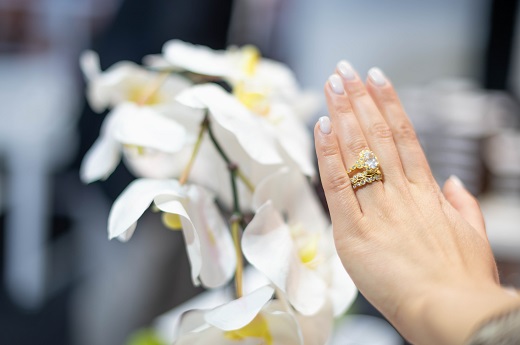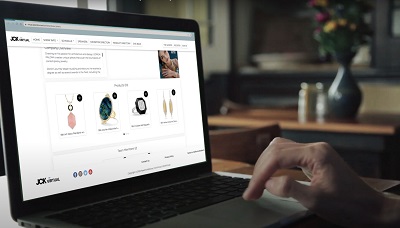How JCK Virtual Compared with the Real Deal
 RAPAPORT... The first JCK Virtual show, which ran from August 11 to 14, was a chance to test a new exhibition model that, if successful, could help companies do business during the coronavirus era. The event was free for exhibitors who had committed to the 2021 show, as well as for buyers and industry professionals, so there was little downside in participating.The initial verdict, however, was that it's no replacement for the traditional format."We really hoped it was going to be good, but we didn't find it totally successful," said Andrew Rickard, vice president of operations at RDI Diamonds, a wholesaler based in Rochester, New York. "Most people that we communicated with [at the show] were vendors trying to sell us, or service businesses trying to communicate with us. I found very few on the retail arena pursuing inventory or pursuing orders."The strength of the traditional JCK Las Vegas, which was canceled due to the coronavirus, lies in the opportunity for face-to-face, relationship-building meetings, Rickard told Rapaport News last week. One can walk around and encounter people and ideas that one might otherwise have missed, he added. Moreover, a lot of business happens while he's hanging out with clients outside of the formal show hours.Online fairs - in their current forms - miss those angles, Rickard argued. His sales at JCK Virtual were "miniscule," and many of his retailer clients were unaware of the event or didn't see the need for it. This was despite steady consumer demand ahead of the holidays. "I could do a Zoom call or a phone call with any of my clients any day," Rickard explained. "I'm not sure it was as appealing to the retailers as we would have liked it to be."The platform did not support direct sales, with users only able to search directories and contact sellers, a JCK spokesperson said. They could request and schedule meetings, hold video calls, exchange messages or speak via chat through the site.The show was good for making connections, even though sales mere minimal, observed Jitendra (Justin) Kasodariya, general manager at India-based polished manufacturer Dharmanandan Diamonds. However, while customers at the physical show tended to visit the company's booth of their own accords, the virtual format forced exhibitors to attract clients more proactively."Here, it's a different experience, because we had to approach customers," he said.Sales and valuable interactions were also the sticking point for Harsh Maheshwari, executive director of Kunming International, a Hong Kong-based supplier of fancy-color diamonds. The site itself was user-friendly, and the tool for matching buyers with sellers was beneficial, as were the educational sessions, he added. "At JCK, there would be a lot of action and understanding the American market's pulse, what the latest trends were, and knowing the direction of the trade," Maheshwari said. "[At the virtual show,] I didn't see a lot of our clients or vendors who I'd normally look out for."Hybrid modelExhibitors agreed that virtual exhibitions were a promising option as long as physical shows remain impossible. One potential direction is for virtual shows to run all year round as networking tools, with real-life meetings complementing them when the virus situation permits. The organizers of Houruniverse, the replacement for Baselworld, plan to follow that concept, offering an annual show in Basel alongside a permanent online platform.JCK is also aiming for a hybrid model, noting that attendees and exhibitors acknowledged the "unparalleled new and modern experience" the virtual show offered, but were also looking forward to returning to the physical fair.
RAPAPORT... The first JCK Virtual show, which ran from August 11 to 14, was a chance to test a new exhibition model that, if successful, could help companies do business during the coronavirus era. The event was free for exhibitors who had committed to the 2021 show, as well as for buyers and industry professionals, so there was little downside in participating.The initial verdict, however, was that it's no replacement for the traditional format."We really hoped it was going to be good, but we didn't find it totally successful," said Andrew Rickard, vice president of operations at RDI Diamonds, a wholesaler based in Rochester, New York. "Most people that we communicated with [at the show] were vendors trying to sell us, or service businesses trying to communicate with us. I found very few on the retail arena pursuing inventory or pursuing orders."The strength of the traditional JCK Las Vegas, which was canceled due to the coronavirus, lies in the opportunity for face-to-face, relationship-building meetings, Rickard told Rapaport News last week. One can walk around and encounter people and ideas that one might otherwise have missed, he added. Moreover, a lot of business happens while he's hanging out with clients outside of the formal show hours.Online fairs - in their current forms - miss those angles, Rickard argued. His sales at JCK Virtual were "miniscule," and many of his retailer clients were unaware of the event or didn't see the need for it. This was despite steady consumer demand ahead of the holidays. "I could do a Zoom call or a phone call with any of my clients any day," Rickard explained. "I'm not sure it was as appealing to the retailers as we would have liked it to be."The platform did not support direct sales, with users only able to search directories and contact sellers, a JCK spokesperson said. They could request and schedule meetings, hold video calls, exchange messages or speak via chat through the site.The show was good for making connections, even though sales mere minimal, observed Jitendra (Justin) Kasodariya, general manager at India-based polished manufacturer Dharmanandan Diamonds. However, while customers at the physical show tended to visit the company's booth of their own accords, the virtual format forced exhibitors to attract clients more proactively."Here, it's a different experience, because we had to approach customers," he said.Sales and valuable interactions were also the sticking point for Harsh Maheshwari, executive director of Kunming International, a Hong Kong-based supplier of fancy-color diamonds. The site itself was user-friendly, and the tool for matching buyers with sellers was beneficial, as were the educational sessions, he added. "At JCK, there would be a lot of action and understanding the American market's pulse, what the latest trends were, and knowing the direction of the trade," Maheshwari said. "[At the virtual show,] I didn't see a lot of our clients or vendors who I'd normally look out for."Hybrid modelExhibitors agreed that virtual exhibitions were a promising option as long as physical shows remain impossible. One potential direction is for virtual shows to run all year round as networking tools, with real-life meetings complementing them when the virus situation permits. The organizers of Houruniverse, the replacement for Baselworld, plan to follow that concept, offering an annual show in Basel alongside a permanent online platform.JCK is also aiming for a hybrid model, noting that attendees and exhibitors acknowledged the "unparalleled new and modern experience" the virtual show offered, but were also looking forward to returning to the physical fair. Participants enjoyed feeling connected through online education, product-browsing and virtual meetings, Sarin Bachmann, group vice president of organizer Reed Jewelry Group, said in a statement Thursday. However, "it was clear the digital experience cannot replace or fully replicate the experience of our in-person trade shows and events, where attendees can touch and feel the products as well as socialize and connect in person," she added.Engaging everyoneAnother challenge is recreating the atmosphere of a trade show, in which thousands of people travel to one place at one time to do nothing but buy, sell and discuss jewelry for a week or longer.Many physical shows have started holding speaker events in a much more informal setting than they used to, encouraging people to pop in and out rather than committing to the full hour. Engaging people from home is harder still, as many in the industry are tired of the busy pandemic webinar schedule and have become accustomed to working while an educational session plays in the background.In addition, virtual shows bring up the question of whether it makes sense to operate on a chosen local schedule or cater to a global audience. JCK Virtual had sessions running from 10 a.m. to 6 p.m. Eastern Time, which was nighttime in the Far East."Why not make it 24 hours? Why not have every market open to it?" said Kunming's Maheshwari. "A lot of the Hong Kong participants were not there. They could have people in every time zone be part of this. And this would definitely attract a lot more visitors."The coronavirus has brought an unprecedented opportunity - and need - to bring trade shows online while working out how to handle these issues. The result of those efforts might be a better virtual show - but it's also likely to leave the industry with a strong desire to return to the familiar format.Main image: Jewelry from the 2019 JCK Las Vegas show. Inset: A virtual showroom at the 2020 fair. (JCK Events)
Participants enjoyed feeling connected through online education, product-browsing and virtual meetings, Sarin Bachmann, group vice president of organizer Reed Jewelry Group, said in a statement Thursday. However, "it was clear the digital experience cannot replace or fully replicate the experience of our in-person trade shows and events, where attendees can touch and feel the products as well as socialize and connect in person," she added.Engaging everyoneAnother challenge is recreating the atmosphere of a trade show, in which thousands of people travel to one place at one time to do nothing but buy, sell and discuss jewelry for a week or longer.Many physical shows have started holding speaker events in a much more informal setting than they used to, encouraging people to pop in and out rather than committing to the full hour. Engaging people from home is harder still, as many in the industry are tired of the busy pandemic webinar schedule and have become accustomed to working while an educational session plays in the background.In addition, virtual shows bring up the question of whether it makes sense to operate on a chosen local schedule or cater to a global audience. JCK Virtual had sessions running from 10 a.m. to 6 p.m. Eastern Time, which was nighttime in the Far East."Why not make it 24 hours? Why not have every market open to it?" said Kunming's Maheshwari. "A lot of the Hong Kong participants were not there. They could have people in every time zone be part of this. And this would definitely attract a lot more visitors."The coronavirus has brought an unprecedented opportunity - and need - to bring trade shows online while working out how to handle these issues. The result of those efforts might be a better virtual show - but it's also likely to leave the industry with a strong desire to return to the familiar format.Main image: Jewelry from the 2019 JCK Las Vegas show. Inset: A virtual showroom at the 2020 fair. (JCK Events)